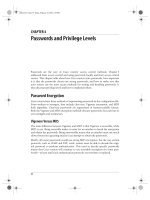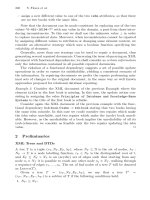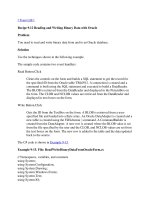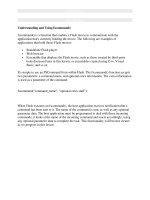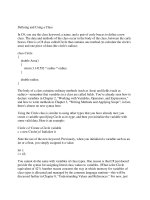Tài liệu Testing and Debugging pdf
Bạn đang xem bản rút gọn của tài liệu. Xem và tải ngay bản đầy đủ của tài liệu tại đây (338.52 KB, 31 trang )
7
Testing and
Debugging
CERTIFICATION OBJECTIVES
7.01 Creating a Unit Test Plan
7.02 Implementing Tracing
7.03 Instrumenting and Debugging a
Windows Service, a Serviced
Component, a .NET Remoting
Object, and an XML Web Service
7.04 Using Interactive Debugging
7.05 Logging Test Results
✓
Two-Minute Drill
Q&A
Self Test
CertPrs8 / MCAD/MCSD XML Web Services and Server Components Development with Visual Basic .NET / Lind / 222653-6 /
Chapter 7
P:\010Comp\CertPrs8\653-6\ch07.vp
Wednesday, October 30, 2002 9:50:38 AM
Color profile: Generic CMYK printer profile
Composite Default screen
CertPrs8 / MCAD/MCSD XML Web Services and Server Components Development with Visual Basic .NET / Lind /
222653-6 / Chapter 7
I
n this chapter, you will learn about the testing process and specifically how unit testing fits
into the overall testing of the application. You will also look at what tracing is and how you
can make use of it, as well as how you implement your remote components and retrieve
that information.
Debugging and especially how you debug remote components interactively will
also be handled here. Another interesting area you will look at is how you can use
SOAP extensions to debug the components.
CERTIFICATION OBJECTIVE 7.01
Creating a Test Plan on the Evolutionary Model
This section will deal with software testing and the unit test in particular. Unit
testing takes the smallest part of software practical and validates its function. The
unit test must be planned and documented according to what is called the unit test
plan. The software that usually is produced to perform the unit test is called the test
harness—software that has stubs and functions that can call on and respond to any
functionality in the unit being tested.
Software testing is a high-priority activity in the production of software
applications. Among other things, the testing process
■
Measures the quality of the software The assumption is that there will
always be flaws in the software that are waiting to be discovered. By testing
and debugging prior to release, you can ensure that your software is regarded
as high-quality.
■
Validates that the application behaves as the user expects it to The application
is tested to ensure that it behaves as described in the documentation, and as the
users expect the application to work.
■
Reduces the cost of development Testing will reduce those costly last-minute
errors that traditionally have delayed products and added to the cost. The unit
test methodology results in individual software components being tested and
validated before they are assembled into increasingly more complex units.
■
Reduces the cost of ownership by minimizing the cost of maintenance
Maintenance cost is determined on how much testing must be performed to
validate the code after the maintenance. Because the testing plans are already
written the unit and integration tests are faster and more accurate.
2
Chapter 7: Testing and Debugging
P:\010Comp\CertPrs8\653-6\ch07.vp
Wednesday, October 30, 2002 9:50:39 AM
Color profile: Generic CMYK printer profile
Composite Default screen
Creating a Test Plan on the Evolutionary Model
3
CertPrs8 / MCAD/MCSD XML Web Services and Server Components Development with Visual Basic .NET / Lind / 222653-6 /
Chapter 7
■
Replaces the traditional development and test planning process The
traditional process follows the waterfall model, where one task flows into the
next in an ordered manner as in the following list:
■
Analyze requirements
■
Create designs and specifications
■
Create the code
■
Test
■
Release
When you reach the testing phase in this model, the application is already finished,
and when problems are identified, there is a major issue: in order to make repairs, you
make changes, but those changes will modify the application, so you need to start
testing again. This cycle of testing and modifications on the finished application can be
never-ending. The development cost also increases enormously—there are estimates
that the cost can increase by 100 times when testing is delayed until the application is
finished.
Unit testing becomes almost automatic because the methodology leads us to
test as you go along, building test harnesses to validate your implementation.
The waterfall model matched the development model for most procedural
environments, but when you moved into object-oriented development, the development
model changed to the evolutionary model, where testing is an ongoing process that is
integrated into the development process.
The steps in the evolutionary model are to
1.
Analyze requirements:
■
Discover classes
■
Develop classes
■
Test the classes
2.
Repeat until the system is complete
The repetitious evolution of the application by building increasingly more complex
parts of the application on already tested units makes it possible to arrive at the end of
the development project with a fully tested application. The additional payback is that
at the end when the complete application is assembled from all the units, there will not
be any devastating errors that require rewriting parts of the application.
P:\010Comp\CertPrs8\653-6\ch07.vp
Wednesday, October 30, 2002 9:50:39 AM
Color profile: Generic CMYK printer profile
Composite Default screen
4
Chapter 7: Testing and Debugging
CertPrs8 / MCAD/MCSD XML Web Services and Server Components Development with Visual Basic .NET / Lind /
222653-6 / Chapter 7
Expect questions that make you select between the waterfall model and the
evolution model. You can rest assured that the evolution model will be the
right answer.
The evolution model uses the iterative steps from object-oriented analysis and
design (OOAD) to continuously analyze the application and build fully tested
parts of that application before moving on to the next cycle, which starts with
analysis again.
The unit test becomes a central task in the development of the application. As
you move forward, you will have more and more fully tested units that can be
assembled into larger units that are then tested, and so on until the application is
finished.
Testing should be planned in a fashion similar to the main development effort.
Planning for testing should be requirements based, drawing the test design from the
requirements section of the software specification. Testing generally identifies defects
(bugs) that allow, create, or cause unexpected behaviors in terms of the requirements.
The requirements for the software must be written in such a way that they can be
directly translated into test documentation. For example, requirements should be
■
Binding The customer demanded them.
■
Testable If you can’t test the requirement, there is no way of proving
compliance.
■
Clear They must be unambiguous and interpretable in only one way.
Planning then proceeds by designing test cases that will validate each of the
requirements. The test plan will outline the entire process with the individual test cases
included. The development of a solid test plan is built on the systematic analysis of the
application to make sure that everything is tested without repetitions. The plan ensures
that testing procedures are known and do not depend on accidental or random testing.
One closely related task to testing is optimization. The optimization task is the process
that removes bottlenecks (overuse of resources) in the software and hardware to produce
the best combination that minimizes resource use. After performing optimization, you
must perform the tests for each unit again to ensure that the optimization exercise did
not break the application.
Testing
The testing exercise consists of three related tasks that together ensure the quality of
the developed software. They are
P:\010Comp\CertPrs8\653-6\ch07.vp
Wednesday, October 30, 2002 9:50:39 AM
Color profile: Generic CMYK printer profile
Composite Default screen
Creating a Test Plan on the Evolutionary Model
5
CertPrs8 / MCAD/MCSD XML Web Services and Server Components Development with Visual Basic .NET / Lind / 222653-6 /
Chapter 7
■
The unit test Testing the smallest possible software unit
■
The integration test Testing combinations of software units
■
The regression test Retesting after modifications to the software units
The exam focuses on the unit test, but to fully understand the testing methodology,
you will cover the other two as well.
Unit Testing
The goal of unit testing is to take the smallest possible testable software that is part of
the application, remove it from the remainder of the software, and test to ensure it
behaves as expected. Unit testing is a natural fit with the OOAD methodology used
for modern software design because it flows naturally from the unit-by-unit iterative
development that you are used to from the OOP world.
The testing process usually requires that you write a test harness that is used to
communicate with the software unit. The terminology used to describe this scenario
is that you will write a driver to simulate the caller and possibly a stub to simulate a
called unit. The test harness becomes part of the applications code base and will be
used for validation through the lifetime of the application.
The cost in time that is involved in writing the test harness makes it tempting to
try to test larger units rather than identifying and testing the smallest possible unit.
The problem with testing larger units is that it increases the difficulty in identifying
where a problem is located. If you have two software units and you decide to test
them together as one unit, you may face the following list of questions, which gives
you an idea of the complexity of finding a bug:
■
Is the error caused by a defect in the first unit?
■
Is the error caused by a defect in the second unit?
■
Is the error caused by a defect in the test harness?
■
Is the error caused by a defect in both the first and second units?
■
Is the error caused by a defect in the interface between the two units?
The complexity introduced makes it very hard to find the source of the
defect—this is one compelling reason for implementing unit testing.
Always select the smallest possible unit for the test.
P:\010Comp\CertPrs8\653-6\ch07.vp
Wednesday, October 30, 2002 9:50:39 AM
Color profile: Generic CMYK printer profile
Composite Default screen
6
Chapter 7: Testing and Debugging
CertPrs8 / MCAD/MCSD XML Web Services and Server Components Development with Visual Basic .NET / Lind /
222653-6 / Chapter 7
EXERCISE 7-3
Unit Testing
In this exercise, you will investigate writing a test harness. For this example, you
have chosen a class as the unit you will test. The exercise is based on a console
application to minimize the complexities.
1.
Open a Visual Studio .NET Command Prompt (Start | Programs | Microsoft
Visual Studio .NET | Visual Studio .NET Tools | Visual Studio .NET
Command Prompt).
2.
Change to the C:\VB directory, or create it if you do not have that directory.
3.
Make a new directory named Testing (md Testing).
4.
Change to the Testing directory (cd Testing).
5.
Create a new Visual Basic .NET class file using your favorite editor. Name
the file Class.vb.
6.
Enter the following source code in the Class.vb source file:
Public Class Temperature
Private m_temperature As Integer
Public Property Temp As Integer
Get
Return m_temperature
End Get
Set(value As Integer)
m_temperature = value – 273 ' Kelvin End Set
End Property
Public Function Celsius() As Integer
Return m_temperature
End Function
Public Function Fahrenheit() As Integer
Return m_temperature
End Function
End Class
7.
Next, write the test harness to test the Temperature class. The logic
behind the test is that you will test the Celsius() and Fahrenheit()
functions to ensure that the class returns the correct value. The test plan is to
use a value of 30 Celsius and verify that it is correctly returned. Create a new
source file in the Testing directory; name the file Harness.vb.
P:\010Comp\CertPrs8\653-6\ch07.vp
Wednesday, October 30, 2002 9:50:39 AM
Color profile: Generic CMYK printer profile
Composite Default screen
Creating a Test Plan on the Evolutionary Model
7
CertPrs8 / MCAD/MCSD XML Web Services and Server Components Development with Visual Basic .NET / Lind / 222653-6 /
Chapter 7
8.
Enter the following Visual Basic .NET code in the Harness.vb file:
Public Class Tester
Public Shared Sub Main()
Dim t As Temperature = New Temperature()
Static Thirty As Integer = 30
t.Temp = Thirty ' assign the property 30 Celsius
' Now test the behavior when the temperature is set to 30 C
Select Case t.Celsius()
Case Thirty
System.Console.Out.WriteLine( _
"The value is correct: {0} (Expected {1}C)", _
t.Celsius, Thirty)
Case Else
System.Console.Out.WriteLine( _
"The value is incorrect: {0} (Expected {1}C)", _
t.Celsius, Thirty)
End Select
Select Case t.Fahrenheit()
Case ((Thirty* 9 / 5)+32)
System.Console.Out.WriteLine( _
"The value is correct: {0} (Expected {1}F)", _
t.Fahrenheit, ((Thirty* 9 / 5)+32))
Case Else
System.Console.Out.WriteLine( _
"The value is incorrect: {0} (Expected {1}F)", _
t.Fahrenheit, ((Thirty* 9 / 5)+32))
End Select
End Sub
End Class
9.
Save the source files and compile them using this command line:
C:\VB\Testing>vbc Harness.vb Class.vb
10.
Run the harness program; the following is the output:
C:\VB\Testing>harness
The value is incorrect: -243 (Expected 30C)
The value is incorrect: -243 (Expected 86F)
As you can see, there is a problem, and if you look at the Temperature
class, you will find that the temperature is stored using the absolute Kelvin
scale, but there is no conversion in the Celsius() or Fahrenheit()
functions. The next step provides the solution to the Celsius() function
problem.
P:\010Comp\CertPrs8\653-6\ch07.vp
Wednesday, October 30, 2002 9:50:39 AM
Color profile: Generic CMYK printer profile
Composite Default screen
8
Chapter 7: Testing and Debugging
CertPrs8 / MCAD/MCSD XML Web Services and Server Components Development with Visual Basic .NET / Lind /
222653-6 / Chapter 7
11.
Correct the Celsius() function to correctly convert from Kelvin to
Celsius. Here is the correct conversion:
Public Function Celsius() As Integer
Return m_temperature + 273 ' convert from Kelvin to Celsius
End Function
12.
Save and compile the harness program.
13.
Execute the harness program. This should be the result:
C:\VB\Testing>harness
The value is correct: 30 (Expected 30C)
The value is incorrect: -243 (Expected 86F)
14.
Correct the problem with the Fahrenheit() function using the
following code segment:
Public Function Fahrenheit() As Integer
Return (((m_temperature + 273) * 9 ) / 5 ) + 32
End Function
15.
Save and compile the harness program.
16.
Execute the harness program.
C:\VB\Testing>harness
The value is correct: 30 (Expected 30C)
The value is correct: 86 (Expected 86F)
Having tested the Temperature class, you can move on to other classes in the
application.
Integration Testing
When the units of the application are completed and tested, they will be assembled
(integrated) into larger units. These new integrated units need to be tested as well, in
what is called integration testing. The most basic integration test takes two tested units
and tests the interface between those two units. This process continues until all units
have been integrated. By working with only two units at a time, the integration testing
becomes manageable, and locating a defect will be much easier and faster.
There are three approaches to integration testing:
■
The top-down strategy In this strategy, you start at the top of the application
and integrate the units to ensure that high-level logic and dataflow are tested early
in the development cycle. The top-down strategy minimizes the need for drivers
(callers), but the need for stubs complicates management of the test. The
low-level units are tested late in the development cycle. The top-down strategy
P:\010Comp\CertPrs8\653-6\ch07.vp
Wednesday, October 30, 2002 9:50:40 AM
Color profile: Generic CMYK printer profile
Composite Default screen
Creating a Test Plan on the Evolutionary Model
9
CertPrs8 / MCAD/MCSD XML Web Services and Server Components Development with Visual Basic .NET / Lind / 222653-6 /
Chapter 7
has very poor support for early (proof of concept), limited-functionality releases
of the application.
■
The bottom-up strategy This strategy starts with the integration of the
lowest-level units first, with the result that the utility level of the application
is tested early in the process. This strategy minimizes the need for stubs while
demanding drivers; the high-level logic and data flow are not tested until the
later stages of the development cycle. The support for early releases is poor.
■
The umbrella strategy In this strategy, you test along the lines of
functional control and data-flow paths. The logic is to integrate low-level
functions first—as in the bottom-up strategy—after which the output from
each function is integrated in the top-down manner. This strategy minimizes
the need for stubs and drivers but also makes management of the testing
effort more complicated. The umbrella strategy leads to the possible early
release of limited-functionality proof-of-concept versions.
The integration testing is completed when the application is ready to be shipped
to the customer.
The most common model for testing is a combination of the umbrella model
and one of the other two models. That way, the early test versions can be
brought together with the users to validate the design as well as the
formalized top-down or bottom-up model. One word of advice, though:
ensure that management of the testing is tightly controlled.
Regression Testing
Regression testing refers to the retesting of units after the unit has been modified. You
perform the regression test by rerunning the original tests that were designed for that
unit. The testing will determine if the modification broke the unit or not. Regression
testing should not be a long process; rather, it should be a very quick go–no go test.
Here are some strategies that can be used during the testing:
■
Look out for side effects of fixes that have been incorporated.
■
Write one regression test for each bug that was fixed.
■
Test fixed bugs directly after the bug is fixed to ensure that the fix has no side
effects.
■
If multiple tests are similar, throw away the least efficient ones.
■
Tests that always pass the program should be archived for historical reasons.
■
Test functionality, not design.
P:\010Comp\CertPrs8\653-6\ch07.vp
Wednesday, October 30, 2002 9:50:40 AM
Color profile: Generic CMYK printer profile
Composite Default screen
10
Chapter 7: Testing and Debugging
CertPrs8 / MCAD/MCSD XML Web Services and Server Components Development with Visual Basic .NET / Lind /
222653-6 / Chapter 7
■
Vary the data for the test, look for data corruption. Try to overflow buffers,
test for logical behavior.
■
Track the memory use of the program.
The groups of tests that need to be maintained in order to be able to perform
regression testing are most effectively stored in a library that constitutes a battery of
standard tests that are used whenever the program has to be tested. One of the tricky
aspects of the test library is to decide what to keep. Don’t spend too much time
analyzing the merits of a particular test case; if you can’t make up your mind, add it
to the library. The content of the library should be analyzed every so often to remove
duplicated test cases as well as invalid tests.
Software testing is as much a science as is software design, and the preceding
information is included as an overview of the topic. Remember that the exam will
assume that you know how to write a test harness for a unit.
Providing Test Data to Components and Applications
The selection of test data for use with the test cases is as important as the design of the
test cases themselves. The data that is used must be selected from the problem domain
of the development project. The data is usually identified during the analysis phase of
the project and should be verified with the domain experts of the project to ensure the
data is valid.
When developing components that quite possibly will be used in an international
environment, it is imperative that you provide for data that is valid for the different
locales of the users of the component. To that end, work with the domain experts to
identify the different locales that will be supported in the design and create data
definitions for each locale.
The most important aspect of the localized component is that the tests must
provide data in the format of the user locale and test that the component performs
the correct conversions. For example, if the locale of the user presents dates in the
YYYY.MM.DD format (2002.09.07), the test data must include that format to
ensure that the conversions work.
CERTIFICATION OBJECTIVE 7.02
Logging Test Results
The performance of tests is one part of testing—but there is an equally important part
that involves the logging or filing of the test data. The logging can be as low-tech as
P:\010Comp\CertPrs8\653-6\ch07.vp
Wednesday, October 30, 2002 9:50:40 AM
Color profile: Generic CMYK printer profile
Composite Default screen
manually filing screen shots and handwritten notes in a filing system, or it can be as
high-tech as using a versioning system that stores the test harness as well as the output
together with the source code.
How you store the test results is not as important as that you store them in a
searchable way. Remember that this involves the Quality Assurance (QA) records of
the software application.
One product supplied by Microsoft as part of Visual Studio .NET is the Visual
SourceSafe (VSS) product. You can use VSS to keep versioned copies of virtually
anything. VSS is the application that makes team-based development possible.
For the exam, you need to know that VSS is a product that is used to store
versioned information about all aspects of the software development process
in a project—including the test reports.
The storing of test results is one of the areas in software testing that usually
is left to chance—which is a shame. You spend a lot of time designing and
executing the tests, but then the results are just stored in a filing cabinet.
Next year, when you need to return to the same application to test it after
maintenance, you need those original results so that you can guarantee that
the maintenance action did not break anything.
Logging Test Results
11
CertPrs8 / MCAD/MCSD XML Web Services and Server Components Development with Visual Basic .NET / Lind / 222653-6 /
Chapter 7
One of the most ignored topics in any course
is the importance of proper testing. I have made
a point of introducing the concept of the test
harness to the students that I teach. When you
implement a class, you always write a small
program—the test harness—that is used to
exercise and test the class.
I have found that the software class is a
manageable unit for testing, but that is based
on the assumption that the classes are built as
small single-use building blocks that will be
assembled into larger classes that in turn are
assembled into the application.
This brings us back to the proper class design
that is the basis of OOAD. With a proper class
design, the test cases will be easy to design and
the iterative nature of OOAD will lend itself to
providing a functional test plan.
FROM THE CLASSROOM
P:\010Comp\CertPrs8\653-6\ch07.vp
Wednesday, October 30, 2002 9:50:40 AM
Color profile: Generic CMYK printer profile
Composite Default screen
CERTIFICATION OBJECTIVE 7.03
Instrumenting and Debugging a Service
Instrumentation is the process of collecting information about a program while it is
running. A number of methods are available to us for collecting that information,
ranging from online debugging to using the performance counters that can be monitored
using operating system tools. The exam will test you on how to add trace statements and
performance counters, and how to debug a remote component using these techniques.
Two different classes are available to us for getting information from the running
application: the Trace class and the Debug class. These two classes are equivalent in
all but one respect—the Debug class will not be available if the application has been
compiled as a Release build, while the Trace class is available in both Debug and
Release builds. As the two classes are equivalent in all but this respect, you will
concentrate on the Trace class in this section. You will start with tracing to explore
the different parts of the environment and how to use them.
Implementing Tracing
Tracing is the method used to monitor your application while it is running in
production. The Trace class gives us the functionality you need to provide a very
functional environment for production instrumentation of your application. The
Trace class is located in the System.Diagnostics namespace. In order to add tracing
to an application, you will need to include the System.Diagnostics namespace and
use the methods of the Trace class.
The six methods in the Trace class that write output are listed in Table 7-1.
12
Chapter 7: Testing and Debugging
CertPrs8 / MCAD/MCSD XML Web Services and Server Components Development with Visual Basic .NET / Lind /
222653-6 / Chapter 7
Method Output
Assert() The output is written if the condition for the Assert is False. If no text is specified,
Assert() outputs a stack trace.
Fail() The text is outputted if present; else, the stack trace.
Write() Outputs the specified text, no carriage return.
WriteIf() Outputs the specified text, no carriage return, if the condition is True.
WriteLine() Outputs the specified text followed by a carriage return.
WriteLineIfy Outputs the specified text, followed by a carriage return, if the condition is true.
TABLE 7-1
The Output Methods of the Trace Class
P:\010Comp\CertPrs8\653-6\ch07.vp
Wednesday, October 30, 2002 9:50:40 AM
Color profile: Generic CMYK printer profile
Composite Default screen

